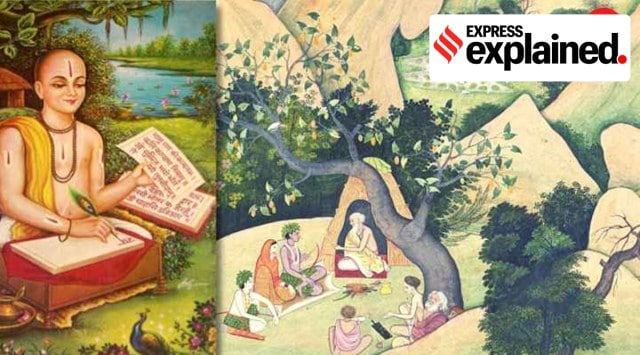“Why was Ramcharitmanas resisted, and which part of it was resisted? Lower castes were denied education, and the Ramcharitmanas says that once educated, lower-caste people become as poisonous as a snake,” Shekhar said at the convocation ceremony of Nalanda Open University.

Days later, Samajwadi Party MLC and a former minister in UP governments led by the BJP and BSP, Swami Prasad Maurya, told a television channel: “Kai crore log isko (Ramcharitmanas) nahin padhte… Dharm ho, hum uska swagat karte hain. Par dharm ke naam par gaali kyon? Dalit ko, adivasiyon ko, pichhdon ko. Jaati lekar ke naam. Shudra keh kar ke, kyon gaali de rahe hain? (Crores of people don’t read Ramcharitmanas. We welcome religion, but why abuse in the name of religion? Dalits, tribals, backwards, naming their castes, abusing them by calling them shudra?)”
The Ramcharitmanas
The poem was written in the 16th century in the Awadhi dialect that is mainly spoken in the areas that are today’s Lucknow, Prayagraj, and Ayodhya districts. It is divided into seven chapters (Kand) that tell the story of Lord Ram from birth to his becoming King of Ayodhya.
The Ramcharitmanas is based on the Ramayana, sage Valmiki’s great epic. It is the holiest book of the Indo-Gangetic region, and among the world’s most read holy books — by one estimate, Geeta Press (Gorakhpur) has sold almost 7 crore copies. Across the Hindi heartland, a reference to “Ramayan” often actually means Ramcharitmanas.
Goswami Tulsidas
Tulsidas, a Brahmin whose original name was Ram Bola Dubey, is believed to have been born in Rajapur by the Yamuna in today’s Banda district. He composed the Ramcharitmanas on the bank of the Ganga in Varanasi — he is said to have begun writing on Ram Navami day in 1574, and completed the poem over the next few years.
In the seventh shloka of the first chapter (Baal Kand), Tulsidas declares, “Swantah sukhay Tulsi Raghunathgatha…” — that is, he has written the “story of Raghunath (Lord Ram) for his own happiness”.
Story continues below this ad
Tulsidas lived in the time of Emperor Akbar, and some believe that he was in touch with Abdurrahim Khan-e-Khanan, the son of Akbar’s commander Bairam Khan, and they possibly exchanged some poetic communication as well.
Tulsidas made the story of Lord Ram popular among the masses because he wrote in the regional dialect that most people understood. This earned him the ire of Sanskrit scholars of the time, and Tulsidas recorded his anguish in his Kavitawali: “...Kahoo ki beti son, beta n byahab, kahoo ki jaati bigad na sou…Maangi ke khaibo, maseet ke soibo, laibo ko eku na daibe ko dou… (I don’t have to marry my son to anyone’s daughter, nor do I have to degrade any caste… I can survive on alms and sleep at the mosque, I have nothing to do (with anyone).”
Portions that are criticised
* The main criticism is of a chaupai in Sundar Kand. Lord Ram is on the coast, but the Sea is refusing to make way. When the Lord threatens to dry the Sea out, he says, “…dhol ganwar shudra pashu naari (imbeciles, illiterates, shudras and women), sakal tadana ke adhikari.” While the Geeta Press Ramcharitmanas (54th edition, 1997) translates “taadan” as “shiksha (education)”, some critics say it means beating or reprimanding.
Story continues below this ad
* In Uttar Kand, Kagbhushundi (the crow) tells Garuda, the king of birds: “Je barnadham teli kumhara, swapach kiraat koli kalwara, naari mui grih sampatti nashi, mood mudai hohin sanyasi (Lower castes like Teli, Kumhar, Chandal, Bheel, Kol and Kalwar, etc. become sanyasis by tonsuring their heads after their wife dies or they lose their wealth).”
* Later, Kagbhushundi says, “Adham jaati may shiksha paaye, bhayau jatha ahi doodh pilaye… (Educating a lower-caste person is like feeding milk to a snake).” This was the line that Bihar Minister Chandra Shekhar mentioned.
* In Aranya Kand, Lord Ram kills the demon Kabandh. When Kabandh mentions Durvasa, Lord Ram praises the sage: “Shapat, tadat parush kahanta, bipra pujya asi gavahin santa, pujiye bipra sheel gun heena, shudra na gun gan gyan praveena (Saints have said that a Brahmin should be respected even if his conduct is not good, and he curses, beats people, or speaks harshly; a Shudra cannot be respected even if he has good qualities and knowledge).”
* When Lord Ram reaches Lanka, Ravan’s wife Mandodari tries to persuade her husband not to go to war. An angry Ravan then describes the eight “avgun (bad habits)” of women.
Story continues below this ad
Past controversies
While in the Ramcharitmanas, Lord Ram is maryada purushottam, the epitome of righteousness, his conduct has been criticised by leaders of anti-Brahmin movements like E V Ramasamy Periyar.
One of the 22 pledges that Dr B R Ambedkar administered to his followers while embracing Buddhism in October 1956 was: “I shall have no faith in Rama and Krishna, who are believed to be incarnation of God, nor shall I worship them.”
Non-upper caste assertion in politics has sometimes been manifested in criticism of the Ramcharitmanas. Critics have used these parts of the poem to accuse Tulsidas of being against the non-upper castes and women, and a flagbearer of the idea of Brahminical superiority.
In 1974, the Socialist Party MLA from Derapur (Kanpur), Chaudhary Rampal Singh Yadav, while participating in a discussion on empowerment of Dalits, tore pages from the Ramcharitmanas in the UP Assembly. Speaker Prof Vasudev Singh frowned at Yadav’s behaviour against a “religious book”, and said “every member should respect all religious books”.








































